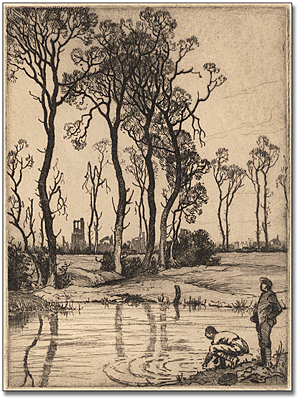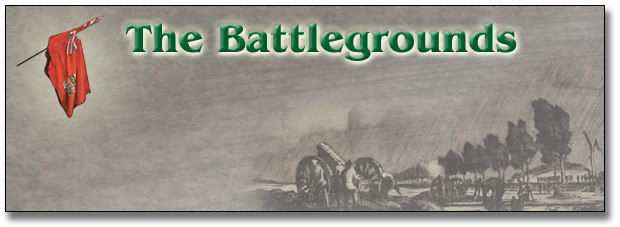
The Second Battle of Ypres, April 1915
The
Canadian 1st Division landed in France and was moved into the
line in front of the Belgian city of Ypres on April 17th, 1915.
Having arrived without any experience of trench warfare and to
a seemingly quiet sector the Canadians were unprepared to fight
in one of the greatest defensive battles ever fought by Canadian
soldiers. This battle became known as the Second Battle of Ypres
and it started five days after the Canadians arrival.
The battle was notable for the first use of chemical weapons (chlorine gas) by the Germans, and the steadfastness of the Canadians in sealing a significant breach in the lines. If the Canadians had not filled the breach and held the line against terrible odds the way would have been open to the German forces for the likely entrapment of 50,000 allied troops.
The cost to the Canadians was great with approximately 6,000 casualties and over 1000 dead.
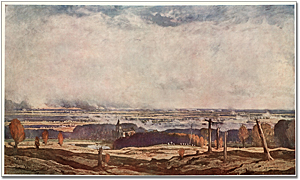
Click to see a larger image (193K)
Ypres From Kemmel, [ca. 1915] (detail)
After D. Y. Cameron, A.R.A.
Reference Code: C 334-2-0-0-5
Archives of Ontario, I0013652
![The Second Battle of Ypres, [ca. 1915] (detail), A fter Richard Jack, A.R.A.](pics/13651_300.jpg)
Click to see a larger image (252K)
The Second Battle of Ypres, [ca. 1915] (detail)
After Richard Jack, A.R.A.
Reference Code: C 334-2-0-0-4
Archives of Ontario, I0013651
The Canadians had held fast at Ypres during their first major encounter with the enemy but there was nothing documenting this heroic stand.
Richard Jack, the first artist to be commissioned by Beaverbrook, undertook the commission sometime after the battle to produce a painting that captured this magnificent action. The scale of Jack’s picture was twelve by twenty feet, a huge canvas that incorporated every icon associated with nineteenth century battle art. A wounded officer waving troops forward; a dying soldier; and other conventions.
But, even though the painting contained numerous inaccuracies, it served its purpose and made for inspiring viewing once shown to the public.
The number of paintings that actually represented a battle in progress was very few and they tended to typify an approach full of heroic gestures, various inaccuracies and sentiment.
The Estaminet dug-out, Ypres front, [ca. 1915]
Alfred Bentley
Reference Code: C 334-1-5-0-11
Archives of Ontario, I0003123
There are a number of recurring
themes and images to be found among the images, but perhaps none
came to represent the devastation of war more than the ruins of
the Cloth Tower in the city of Ypres.
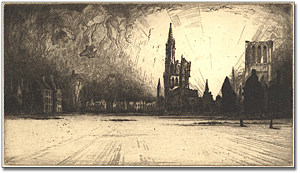
Click to see a larger image (171K)
View of Ypres, France, 1914
Bertram Buchanan
Reference Code: C 334-1-5-0-3
Archives of Ontario, I0003127
![The ruins of Ypres, [ca. 1915]](pics/3125_300.jpg)
Click to see a larger image (217K)
The ruins of Ypres, 1917
Bertram Buchanan
Reference Code: C 334-1-5-0-1
Archives of Ontario, I0003125
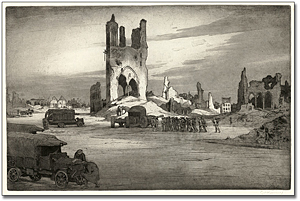
Click to see a larger image (175K)
The Great Square Ypres, 1917
Lieut. C.H. Barraud
Reference Code: C 334-1-2-0-21
Archives of Ontario, I0013632
|
The Great Square, Ypres |
|
Ypres - From Railway Dugouts |
Ypres - From Railway Dugout, April 4, 1916
Lieut. C. H. Barraud
Reference Code: C 334-1-2-0-4
Archives of Ontario, I0003106
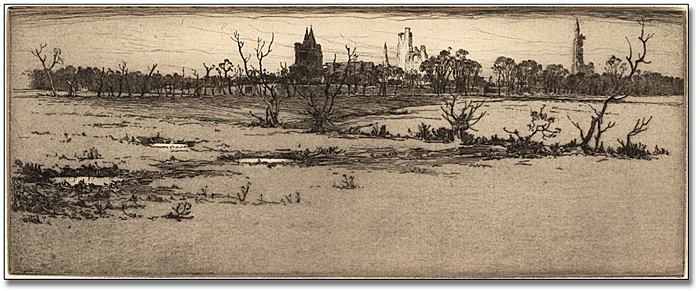
Click to see a larger image (159K)
A view of Ypres from the Bund dugout, May 13, 1917
Lieut. C. H. Barraud
Reference Code: C 334-1-2-0-14
Archives of Ontario, I0003113
|
Ypres from Bund Dugouts |
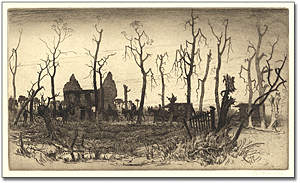
Click to see a larger image (200K)
Evening on the Ypres-Poperinghe Road, 1917
Lieut. C. H. Barraud
Reference Code: C 334-1-2-0-19
Archives of Ontario, I0013634
|
Evening on the Ypres-Poperinghe Road, 1917 |
The Battle of Ypres did much to establish the reputation of the Canadians as a fighting force and directly gave weight to the national policy of keeping Canadian troops together rather than dispersing them under British command.
Vimy Ridge and Mont St. Eloy
The Germans occupied Vimy Ridge in September 1914 at which time it was turned into a very strong defensive position with protection from artillery and infantry.
The French in trenches opposite also reinforced their positions and then over several months made repeated attempts to take the ridge at a cost of over 150,000 casualties.
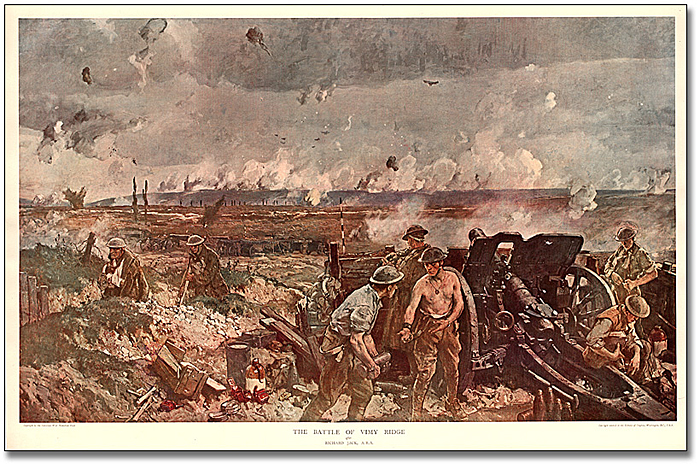
Click to see a larger image (250K)
The Battle of Vimy Ridge, [ca. 1917] (detail)
After Richard Jack, A.R.A.
Reference Code: C 334-2-0-0-3
Archives of Ontario, I0013650
The Canadians took over this stretch of the line during the winter of 1916 and soon the four Canadian Divisions numbering 30,000 men were being prepared to participate in a major offensive that included taking the 60 meter high ridge in front of them.
The battle started on the evening of April 8th 1917. The Canadians had great success in achieving their objectives with the notable achievement of forcing the German troops from the top of Vimy Ridge and down to the plain below.
The Canadians held their ground and on the 12th of April under the cover of darkness the German troops withdrew. The Canadians had broken through the most formidable part of the lines where all others had failed. They had inflicted heavy enemy casualties and captured the high ground, a most important tactical success.
![The trenches at Vimy, [ca. 1916]](pics/3122_300.jpg)
Click to see a larger image (150K)
The trenches at Vimy, [ca. 1916]
Alfred Bentley
Reference Code: C 334-1-5-0-10
Archives of Ontario, I0003122
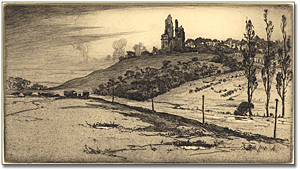
Click to see a larger image (150K)
Mont St. Eloy from the southeast, May 7, 1917
Lieut. C. H. Barraud
Reference Code: C 334-1-2-0-2
Archives of Ontario, I0003104
|
Mont St. Eloy |
![View of Mont St. Eloy, [ca. 1916]](pics/3111_300.jpg)
Click to see a larger image (143K)
View of Mont St. Eloy, [ca. 1916]
Lieut. C. H. Barraud
Reference Code: C 334-1-2-0-12
Archives of Ontario, I0003111
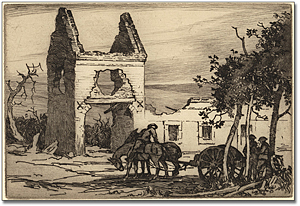
Click to see a larger image (247K)
Berthenval Farm near Vimy Ridge, 1916
Lieut. C. H. Barraud
Reference Code: C 334-1-2-0-7
Archives of Ontario, I0003100
|
Berthenval Farm |
![The Estaminet dug-out, Ypres front, [ca. 1915]](pics/3123_300.jpg)
